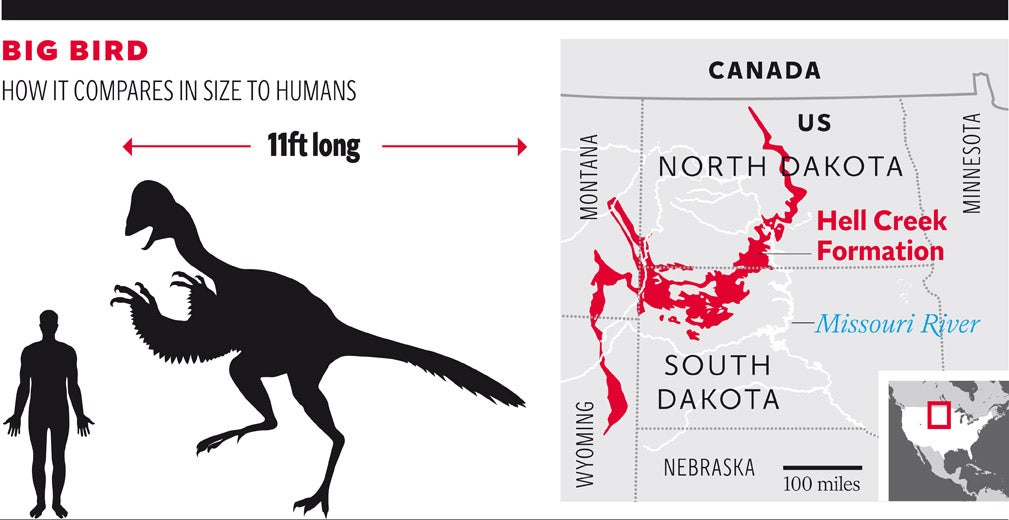Meet the 'chicken from hell': Scientists discover fearsome new species of birdlike dinosaur named 'Anzu wyliei'

Your support helps us to tell the story
From reproductive rights to climate change to Big Tech, The Independent is on the ground when the story is developing. Whether it's investigating the financials of Elon Musk's pro-Trump PAC or producing our latest documentary, 'The A Word', which shines a light on the American women fighting for reproductive rights, we know how important it is to parse out the facts from the messaging.
At such a critical moment in US history, we need reporters on the ground. Your donation allows us to keep sending journalists to speak to both sides of the story.
The Independent is trusted by Americans across the entire political spectrum. And unlike many other quality news outlets, we choose not to lock Americans out of our reporting and analysis with paywalls. We believe quality journalism should be available to everyone, paid for by those who can afford it.
Your support makes all the difference.A two-legged dinosaur with a fearsome beak and a set of sharp claws on each of its feathered fore-limbs has been described as the “chicken from hell” by the scientists who discovered it among a collection of fossilised bones unearthed from a dried-up mud-plain in the American mid-west.
The bird-like dinosaur stood about 10 feet tall on its hind legs, weighed around 500 pounds and roamed the earth at the same time as the largest ever land predator, Tyrannosaurus rex, about 66 million years ago – just a million or so years before all the dinosaurs went extinct.
The dinosaur was decorated with a crest-like ornament on its head and with its long tail it looked like a cross between a modern emu or cassowary and a reptile, the scientists said. “We jokingly call this thing ‘the chicken from hell’, and I think that’s pretty appropriate,” said Matt Lamanna of the Carnegie Museum of Natural History in Pittsburgh, Pennsylvania.
Bones from three specimens were put together to construct the entire skeleton of the creature, named Anzu wyliei, which showed that it belonged to the oviraptorosaurs, a group of bird-like dinosaurs that have been discovered as far afield as the fossil beds of China and North America.
“It was a giant raptor, but with a chicken-like head and presumably feathers. The animal stood about 10 feet tall, so it would be scary as well as absurd to encounter,” said Emma Schachner of the University of Utah, co-author of the study published online in the journal Plos One.
“I am really excited about this discovery because Anzu is the largest oviraptorosaur found in North America. Oviraptorosaurs are a group of dinosaurs that are closely related to birds and often have strange, cassowary-like crests on their heads,” Dr Schachner said. “Two of the specimens display evidence of pathology. One appears to have a broken and healed rib, and the other has evidence of some sort of trauma to a toe,” she said.

The three partial skeletons were recovered some years ago from fossil sites in the Hell Creek Formation which straddles the state border between North and South Dakota. However, it was only recently that the scientists had been able to bring the fossils together to construct an almost complete skeleton.
“For almost a hundred years, the presence of oviraptorosaurs in North America was only known from a few bits of skeleton, and the details of the appearance and biology remained a mystery,” said Hans-Dieter Sues of the Smithsonian National Museum of Natural History in Washington DC.
“With the discovery of Anzu wyliei we finally have the fossil evidence to show that this species looked like and how it is related to other dinosaurs,” Dr Sues said.
The researchers believe that Anzu was an omnivore that ate a variety of plants, small animals and eggs with its toothless beak. Its fossilised bones were recovered from a type of rock called mudstone which suggested that it lived in wet floodplains, they said.
“Over the years, we’ve noticed that Anzu and some other Hell Creek Formation dinosaurs, such as Triceratops, are often found in mudstone rock that was deposited on ancient floodplains,” said Tyler Lyson of the Smithsonian National Museum of Natural History in Washington DC.
“Other dinosaurs like duckbills are found in sandstone deposited in or next to rivers,” Dr Lyson said.
Subscribe to Independent Premium to bookmark this article
Want to bookmark your favourite articles and stories to read or reference later? Start your Independent Premium subscription today.
Join our commenting forum
Join thought-provoking conversations, follow other Independent readers and see their replies
Comments